The lower leg bones can rotate relative to the thigh bones. This is more noticeable when the knees are bent. However there can be slight rotation even when the knees are straight. There are muscles, the long hip muscles, that can be used to rotate the shins relative to the thigh and hip bone. These muscles attach between the hip bones and the lower leg bones. These same muscles can also be used to drive shin rotation relative to the feet while standing with the knees straight.
Foot muscles that can drive shin rotation relative to the feet include tibialis posterior, peroneus longus, peroneus brevis and tibialis anterior.
The following exercises are about using these long foot muscles to stabilize the lower leg bones, ankles and feet.
So that it is easier to use the long foot muscles as opposed to the long hip muscles, the following shin rotation exercise is best done with knees slightly bent while standing with feet parallel and about hip width or shoulder width apart.
First practice rolling your shins inwards and then outwards without moving the feet.
Notice as you roll your shins inwards, you inner arches tend to flatten.
As you roll your shins outwards, your inner arches lift.
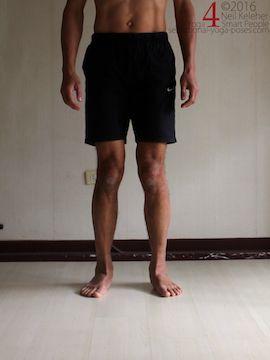
Shins rotated inwards.
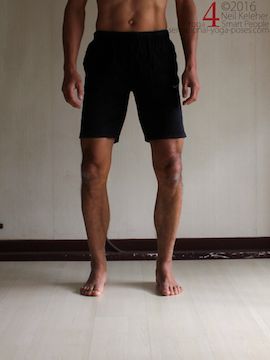
Shins rotated outwards
You may find that the inside edge of your forefoot also lifts when rolling your shins out.
After a rest, continue to rotate your shins inwards and outwards but this time focus on feeling your heels.
Rotating your shins inwards see if you can notice the inner edges of your heels moving downwards or perhaps even pressing down into the ground.
When rotating your shins outwards, see if you can feel the outer edges of your heels pressing down into the ground.
Continue the shin rolling exercise, this time focusing on the inner edge of your forefoot.
As you roll your shins outwards, keep the inside part of the forefoot (the root of the big toe) on the floor. Don't allow it to lift.
Also, while rolling your shins inwards and outwards, keep the bend in your knees constant.
As well as keeping your inner forefoot grounded, now as you roll your shins outwards, feel like you are pulling downwards and backwards on the inner edge of the forefoot.
Feel as if you are trying to pull the inner edge of the forefoot towards the inner edge of the heel.
This should create tension along the inside edge of the foot. This will help to activate the tibialis posterior muscle.
Once comfortable with the above action, you can accentuate it by pulling creating a forwards pull on the inside edge of the heel. Create a rearwards pull on the inner forefoot and at the same time a forwards pull on the inside edge of the heel.
It can feel like you are trying to squeeze the inside edge of your forefoot and heel towards each other.
This dual action deepens the activation of the tibialis posterior muscle, in particular adding tension to the branch of the tendon that attaches to the sustentaculum tali, a projection that arises from the inside edge of the calcaneus, or heel bone.
You can also rotate your shins while focusing just on the inside edge of the heel. This may be helpful when focusing on heel stabilization.
Notice that for all of the above activations, relax the activation when rolling the shin inwards.
Next, focus on the outside edge of the foot. As you roll your shin outwards, try to pull upwards and rearwards on the center of the outer edge of the foot.
Do continue to "clamp" the inner forefoot and inner heel towards each other.
As you do this latter action you may notice that it creates a line of tension up the outside of the lower leg (along the outer face of the fibula).
This will peroneus longus activating and maybe also peroneus brevis.
Practice the above activations with various degrees of external shin rotation.
- Try it with the shins fully rotated externally.
- Try it with the shins rotated just enough that they point straight ahead.
- Try it with minimal external shin rotation so that the inner arches of your feet are slightly flat.
You may notice that with slightly less shin rotation, your tibialis anterior, at the front of your shins, also activates.
With tibialis posterior, and peroneus longus (and possibly peroneus brevis and tibialis anterior) all activated you may find that your feet, ankle and shins are reasonably stable.
You shins will be stabilized against rotation.
Try the same exercise with the heels lifted. Initially try it with heels slightly lifted (say an inch or less). Then try it with heels lifted as high as possible.
If you can remember the feeling of tension you experienced in the feet while doing the exercises with heels down, try to recreate that sensation with heels lifted.
You could think of the activations as "stiffening the feet."
When you lift your heels (keeps your knees slightly bent) notice how your forefeet and toes press down into the floor. (If you shift back just enough, you may find that just your forefeet press down and your toes can relax a little!)
With external rotation the inner edge of the forefeet may lift while with internal rotation the outer edge of your forefeet may lift.
For the next shin stabilization exercise, focus on the heels.
With knees slightly bent and feet flat on the floor:
- as you roll your shins out try to pull the inner edges of your heels forwards and upwards.
- Then as you roll your shins outwards try to pull the outer surface of your heel forwards and up.
So that you get more sensation, try resisting both actions.
The goal is to be able to stiffen your heels so that they resist side to side tilting.
If you can successfully stiffen your heels you may notice tension close to the back of the lower leg bones as well as along the side of the shins. This is a sign that tibialis posterior is activating. Additionally you may find that tibialis anterior also activates.
This latter heel stabilizing action may be very handy for dealing with knee pain particularly IT band knee pain.
However, foot stabilization with a focus on the forefoot should also be practiced. You may find that in some positions heel stabilization is more helpful, in others it helps to use the forefoot.
A simple exercise for feeling forefoot stabilization is to shift your weight forwards while standing so that your forefeet and toes press into the floor. Lift your heels an inch off of the floor slowly. Lower your heels and shift back enough that your heels press down. Notice the sensation in your forefeet with heels down.
Notice the activation that occurs when you lift your heels.
Try to recreate that sensation without lifting your heels.
Once you are used to stabilizing the forefoot (or "foot") and the heel, work at stabilizing in any position. So for example, initially you were focusing on stabilizing the feet with the shins rotated externally. See if you can stabilize the feet and/or heels with the shins rotated internally, or in any position in between.
Also try shin rotation with the knees straight. See if you can continue to use your foot muscles to rotate the shins. A tip, focus on feeling your feet and ankles!
You can also practice rotating your shins in chair pose or while in a deep squat.
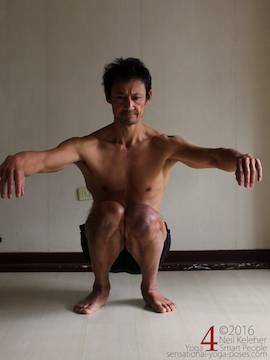
Shins Rotated inwards while in a deep squat.
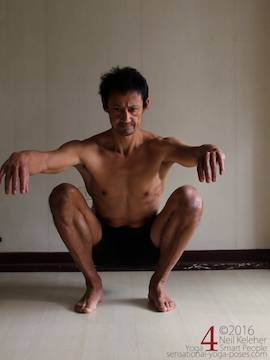
Shins rotated outwards while in a deep squat.
To prevent injury, focus on rotating your shins slowly and smoothly so that you can easily stop if there is any pain.
In chair pose or a deep squat you can also practice stabilizing your feet and/or heels with the shins rotated in different positions.
You can also practice foot and heel stabilization with the feet turned out to various degrees.
For another look at foot stabilization you can read foot exercises.
Published: 2020 08 05
Updated: 2021 02 22

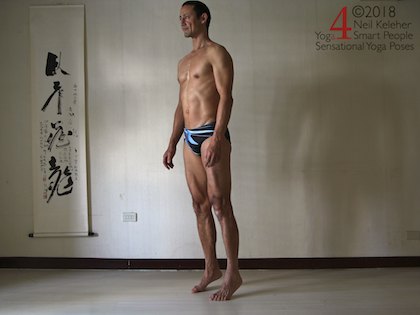
 Shins rotated outwards
Shins rotated outwards



